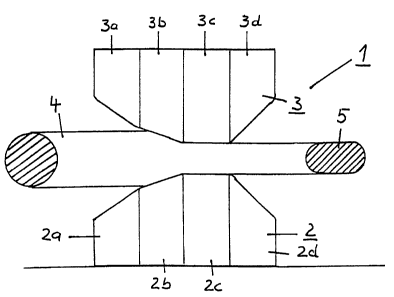Some of the information on this Web page has been provided by external sources. The Government of Canada is not responsible for the accuracy, reliability or currency of the information supplied by external sources. Users wishing to rely upon this information should consult directly with the source of the information. Content provided by external sources is not subject to official languages, privacy and accessibility requirements.
Any discrepancies in the text and image of the Claims and Abstract are due to differing posting times. Text of the Claims and Abstract are posted:
| (12) Patent: | (11) CA 2436755 |
|---|---|
| (54) English Title: | METHOD OF CONTINUOUS PRODUCTION OF METAL WIRES |
| (54) French Title: | METHODE DE PRODUCTION CONTINUE DE FILS METALLIQUES |
| Status: | Deemed expired |
| (51) International Patent Classification (IPC): |
|
|---|---|
| (72) Inventors : |
|
| (73) Owners : |
|
| (71) Applicants : |
|
| (74) Agent: | ROBIC |
| (74) Associate agent: | |
| (45) Issued: | 2009-08-04 |
| (22) Filed Date: | 2003-08-07 |
| (41) Open to Public Inspection: | 2004-02-13 |
| Examination requested: | 2006-05-16 |
| Availability of licence: | N/A |
| (25) Language of filing: | English |
| Patent Cooperation Treaty (PCT): | No |
|---|
| (30) Application Priority Data: | ||||||
|---|---|---|---|---|---|---|
|
In a method for continuous production of metal wires, the cross section of a round metal wire is reduced in one or more stages. To do so, the metal wire is shaped in a bore that is open on one side to form a flat wire at least in the last stage.
Dans une méthode de production en continu de fils de métal, la section transversale d'un fil de métal rond est réduite en une ou plusieurs étapes. Pour ce faire, le fil de métal est formé dans un trou ouvert d'un côté pour former un fil plat au moins à la dernière étape.
Note: Claims are shown in the official language in which they were submitted.
Note: Descriptions are shown in the official language in which they were submitted.

For a clearer understanding of the status of the application/patent presented on this page, the site Disclaimer , as well as the definitions for Patent , Administrative Status , Maintenance Fee and Payment History should be consulted.
| Title | Date |
|---|---|
| Forecasted Issue Date | 2009-08-04 |
| (22) Filed | 2003-08-07 |
| (41) Open to Public Inspection | 2004-02-13 |
| Examination Requested | 2006-05-16 |
| (45) Issued | 2009-08-04 |
| Deemed Expired | 2012-08-07 |
There is no abandonment history.
| Fee Type | Anniversary Year | Due Date | Amount Paid | Paid Date |
|---|---|---|---|---|
| Application Fee | $300.00 | 2003-08-07 | ||
| Registration of a document - section 124 | $100.00 | 2003-10-17 | ||
| Maintenance Fee - Application - New Act | 2 | 2005-08-08 | $100.00 | 2005-07-26 |
| Request for Examination | $800.00 | 2006-05-16 | ||
| Maintenance Fee - Application - New Act | 3 | 2006-08-07 | $100.00 | 2006-07-21 |
| Maintenance Fee - Application - New Act | 4 | 2007-08-07 | $100.00 | 2007-07-25 |
| Maintenance Fee - Application - New Act | 5 | 2008-08-07 | $200.00 | 2008-07-24 |
| Final Fee | $300.00 | 2009-05-14 | ||
| Maintenance Fee - Patent - New Act | 6 | 2009-08-07 | $200.00 | 2009-07-27 |
| Maintenance Fee - Patent - New Act | 7 | 2010-08-09 | $200.00 | 2010-07-23 |
Note: Records showing the ownership history in alphabetical order.
| Current Owners on Record |
|---|
| NEXANS |
| Past Owners on Record |
|---|
| LOTTNER, GUENTER |